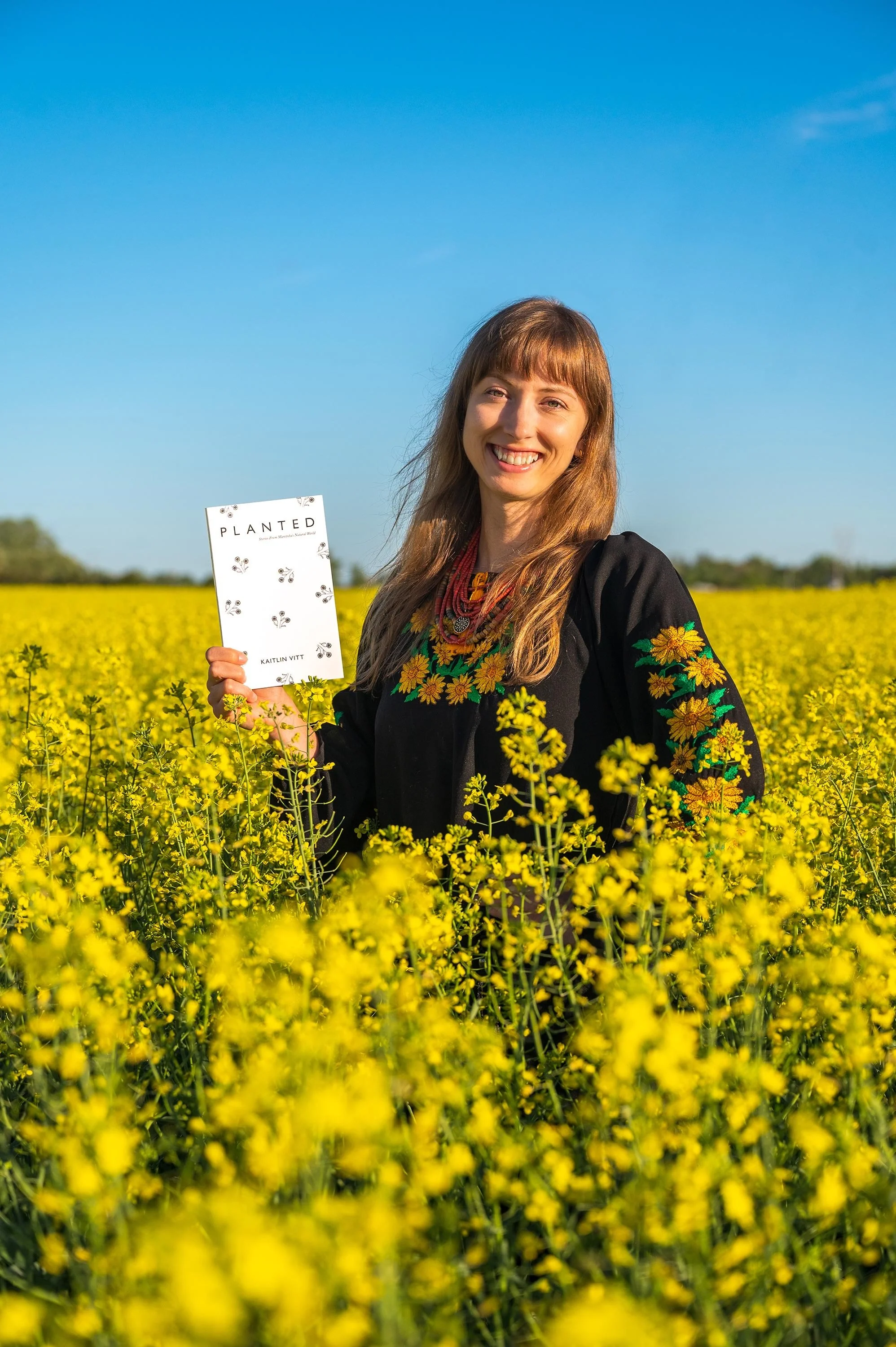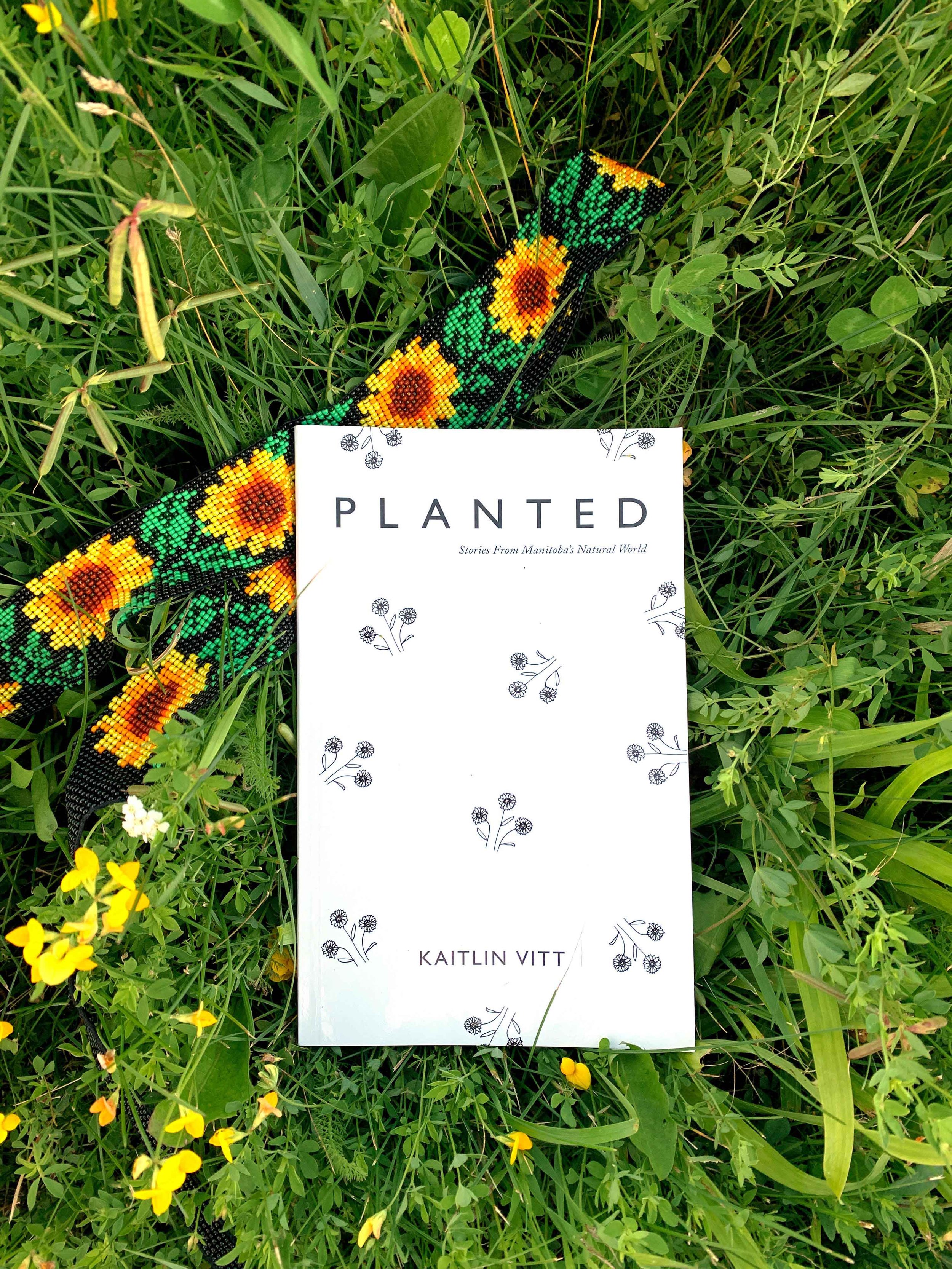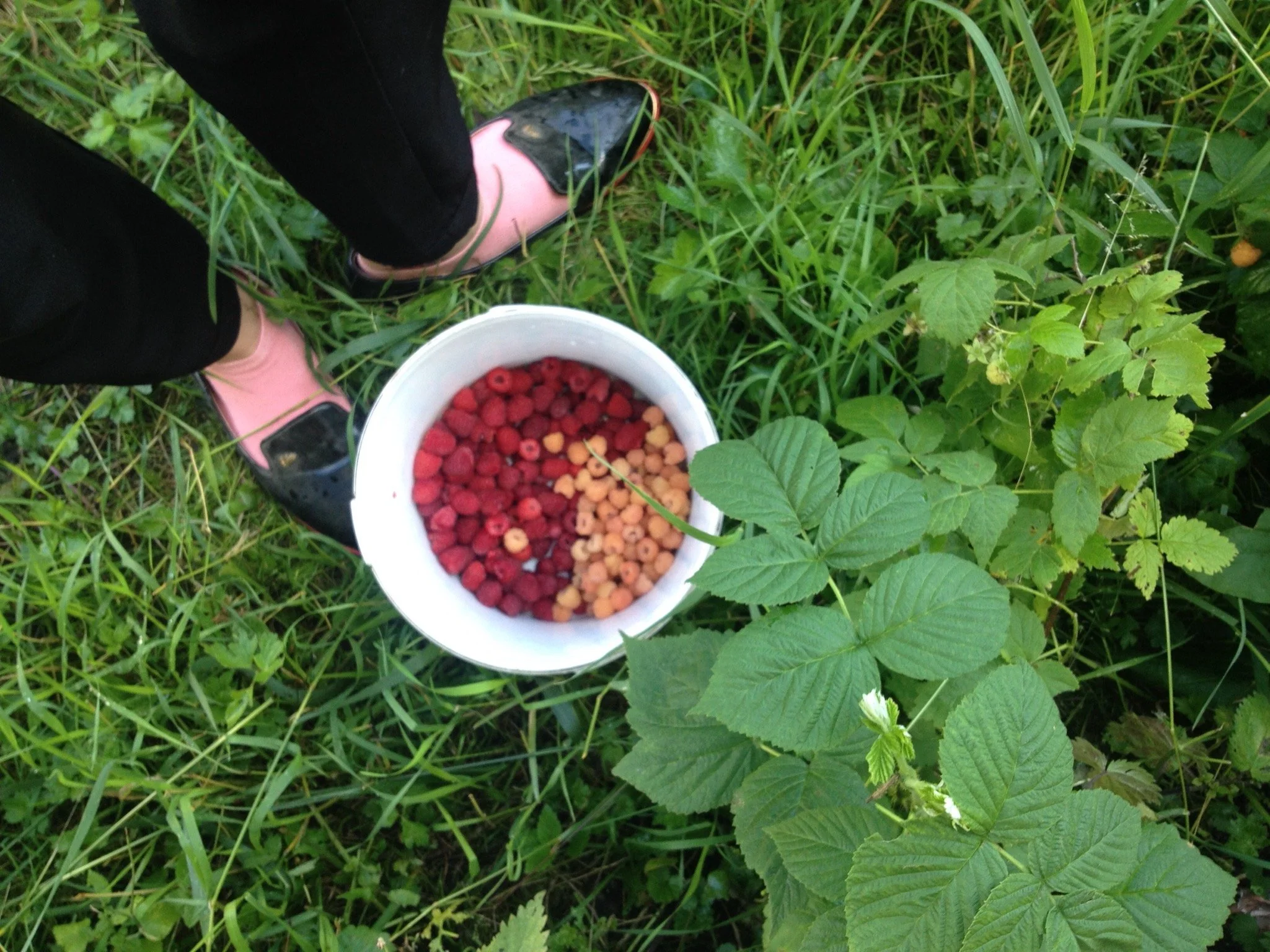Interview with Kaitlin Vitt, author of Planted: Stories From Manitoba’s Natural World
It’s Hannah here.
Kaitlin with her latest edition of Planted: Stories from Manitoba’s Natural World.
Kaitlin is here too but not exactly the same way she usually is! Kaitlin switched roles for this episode and is sitting on the other side of the interview table. She recently reprinted her book Planted: Stories From Manitoba’s Natural World, and it’s on sale now. She has made some updates to the original book she released five years ago, and proceeds are being donated to humanitarian aid in Ukraine.
Click here to listen to the episode, or read on below for the transcript!
Rapid-fire Round
Just like we do for many of our guests, here’s a round of rapid-fire questions. Here are Kaitlin’s answers to my (not-so-quick) q’s!
The first plant you learned to forage was… Not even to identify? I was going to say poison ivy, but I need to think about what I foraged first. I’m going to say chokecherries.
Your favourite plant to look at is… I’m going to give a pretty generic one. It’s actually any seedling. I absolutely love the joy of seeing a little sprouting plant — any plant when it’s tiny, tiny, tiny.
If you’ve seen Kaitlin’s balcony in the spring it’s full of red solo cups with seedlings in each, so that’s fitting.
Your favourite plant to eat is… (But it doesn’t have to be a plant because I think you will say a mushroom.) Yes, pidpenky or honey mushrooms from the forest in my parents’ yard.
The Q + A
Now that you’re kind of warmed up tell us about your book.
It’s called Planted: Stories From Manitoba’s Natural World. It’s a narrative non-fiction book where I share the experiences of eight people who are inspired by nature and have stories to tell because of it. These are true stories that read sort of like short stories. There are stories of survival, healing, self-discovery, tradition, and traditional medicine. It’s all sort of a reminder of the importance of protecting nature and caring for the land.
You first wrote this book five years ago. What was the reason for writing it back then, and why did you decide to reprint it five years later?
Five years ago, in 2017, I graduated from Red River College in Winnipeg and majored in journalism. The final project we had to do was a big one — some people put on events, hosted fundraisers, made websites. I decided to do a book. Basically it was a requirement for school. I self-published and printed it in Winnipeg, my sister Rayna did drawings for the book, and my sister-in-law helped with some of the design.
I reprinted it this year with proceeds from each book going toward Ukraine and relief in Ukraine. I think like many people, in February when the full-scale invasion started, I felt so many feelings — feeling helpless, feeling like I want to do more, feeling guilty because I couldn’t bring myself to do more. I saw other people organizing fundraisers and doing all they could to help.
I know that sharing information is important and talking about the war is important, but I also know that a big part that can help Ukraine win this war is raising money for things they need to protect and care for themselves.
On March 2, I was tidying my home, and all of a sudden I just thought, “Why not reprint the book?” A few people had asked me for copies, but I didn’t have any left. I had been thinking about republishing the book, but I knew I also wanted to do some updates to it. Until this spring, I just didn’t have the drive to do it before. When I realized that I can really help and raise money, that was the motivation I needed to actually get the work done.
I said this idea came to me on March 2, which just so happened to be the exact date since I had my original book launch five years earlier — I didn’t put that together until afterwards. I even told a friend about my idea that day, and she told me she had just picked up my book to move it to the coffee table after not looking at it for a while. All of these little synchronistic things confirmed this was what I had to do, along with knowing it could help me raise money for Ukraine.
I did do some updates to the original version. I wrote a new introduction that explains a bit about my connection to Ukraine, why I’m doing this, and why my love of nature is inspired by my Ukrainian heritage — Ukrainians are so connected to nature and plants. The book also features some new drawings by my sister Rayna Meakin.
Rayna Meakin, Kaitlin’s sister, created the illustrations in Planted.
There are a couple updates to chapters throughout. The biggest update was to the chapter “For Summer.” In 2015, Lindsey Emberley and her infant daughter were in a car crash, and her daughter, Summer, passed away. Lindsey and her daughter loved spending time together in nature — Lindsey is such an outdoors person in general. When her daughter passed away, she found a lot of healing through nature and found ways to connect to her daughter just by being outside.
Lindsey told me how when she and Summer went to the zoo, a butterfly stayed on Summer the whole time. Butterflies have always seemed to be a reminder of Summer to Lindsey.
Summer’s passing was incredibly difficult for Lindsey. One day, when she was having a particularly tough time, Lindsey went out into nature, and said “Summer I need to see you. Show me a sign. I need the support.” All of a sudden, she was surrounded by a swarm of butterflies, and just as quickly as they came, they left her. She just knew that was Summer and that was her showing that Lindsey has the strength she needs to support herself. She has a few instances where she has beautiful connections with nature.
In the first edition of the book, the chapter ended saying Lindsey was ready to create life again. Five years later, she has a son, and I wanted to give an update on where Lindsey is at now. I see her and her son out in nature all the time — foraging for mushrooms, gardening, fishing. We talked about how she continues to be connected to Summer through nature and how she is sharing this love of nature with her son.
Besides having to do this for a school project, what was the inspiration that got you started on this book?
I think throughout my life in general I always wanted to write a book. I have a science background — just like Hannah I graduated with a bachelor of science. I also studied writing and really enjoyed that and wanted a way to combine the two.
I found when I was studying science, there was often a disconnect between scientists and the reason they were doing things — this is a generalized statement and doesn’t apply to everyone, but this is what I experienced. People were doing science but not really knowing why. And then in the public, I saw people enjoying nature and using it but not realizing the importance of protecting nature so they can continue having these stories and adventures in nature. I saw this disconnect and knew I wanted to do something along those lines.
The story that inspired the whole thing is Nadia’s — it’s the first story in the book. She is the aunt of my godmother. I heard this story in realtime while it was happening. I’m not going to give everything away, but she was out mushroom picking, and she got separated from her picking party. It’s her story of survival in the woods near Stead, Manitoba.
I found her story so interesting and had an idea to feature it somehow but wasn’t sure how to present it. I remember talking with my brother, and we just decided I should include it in a book with other stories.
You mentioned that you noticed the disconnect between science and the enjoyment of nature while you were in university, but I don’t think that’s also when your love for nature started. When did your connection to nature begin?
My family is very outdoorsy. I have vivid memories of camping and fishing and going critter dipping — taking a mesh strainer at the end of a stick and finding what’s in the ditch. My family gardened also gardened, including my Baba and Gigi, my grandparents. My Baba and Gigi, who are Ukrainian, would forage for mushrooms like pidpenky and go berry picking. My interest in nature was definitely influenced by my family.
I started studying science because I liked biology, but I also got too caught up in the scientific side of it without seeing the beauty in it all. For whatever reason, the turning point was when I learned about the life cycle of mushrooms — I think because they have a lot more similarities to animals than to plants, which I find fascinating. I didn’t even like to eat mushrooms until I learned about them. It demonstrated that once I learned about something, I had this better appreciation for it.
I read the first version of Planted on the plane home from Ukraine in 2018. I read the most recent version just a couple of weeks ago. I felt like I was reading a different book. Yes, there are updates. But it felt like because I have grown as a person and have had different experiences since the first time I read it, I had a different appreciation for the book and the stories I was reading. Because I’m at a different point of my life, reading it this time felt very different. It was so good.
Thank you. That’s sort of my dream when I hear people can find something in what I write. This isn’t to say something about my writing; it’s to say something about these peoples’ stories! They are amazing.
And of course in the second version of Planted the connection to Ukraine is extra special. The preface was very emotional for me and I’m sure for many people who have a connection with Ukraine. I think anyone who knows you and how much Ukraine means to you will be touched as well — a lot of heartfelt words. This book shows a true appreciation and connection for nature, your Ukrainian roots, and love for Ukraine.
Yes, and there are so many nature connections in Ukrainian traditions, stories, and songs. I mention this in just a few quick sentences in the book, but nature is an important part of Ukrainian culture.
Are there any nature-related experiences that stand out for you from when you’ve been in Ukraine?
One that comes to mind is when I was in my family’s village. I was there a couple of times, and in June 2018, I spent a night there. This isn’t a major nature story, like exploring nature in the Carpathian Mountains — this took place in a village near Terebovlya — but I still consider it a nature story.
The nearby town was celebrating its birthday, so I went there with my cousin at night. We met up with his friends and had the most beautiful night. There was a fair with a Ferris wheel and other rides. We went to the town club, which is more like a pub, and we sat outside. Nearby in the parking lot, there was a huge, blazing fire and techno music playing.
One of Kaitlin’s favourite nature memories is picking berries with her family in Ukraine.
We’re all sitting at a table — my cousin, his friend, and his friend’s girlfriend — with one empty chair. People just kept cycling through the chair, asking who I was and catching up with my cousin. My Ukrainian is not great, but when you’re immersed in it like I was that day it feels like your skill level goes up by 100 per cent. We were trying to have conversations, and I remember not understanding my cousin’s friend, but instead of speaking more slowly he just kept speaking louder and louder — here he is just shouting at me and speaking so fast. It was funny. I remember laughing in his face a couple times. At the end of the night, we drove someone else home, different than the person we drove there, and we picked up some drinks at the gas station and sat in my cousin’s driveway continuing our conversation.
The next morning, after the coziest sleep, my aunt made me breakfast. I went outside to pick berries with my cousin. Near their house they have three different types of raspberries — red, white, and black — and we were picking berries all morning, while my cousin keep getting phone calls. He’d be like, “Hey, how’s it going? I’m good. Just out picking berries with my sister. (Ukrainians don’t differentiate between siblings and cousins). We were out last night and this person was there. But this other person wasn’t there. ”
He just get chatting, making phone call after phone call, catching everyone up on the night. After talking to one person, he passed me the phone, and it was his friend who was shouting at me. He was asking funny little questions to check in on me, asking if my head hurt, what I was doing, what kind of berries there were, how many berries there were. It was really sweet. We finished picking berries and then went to the front yard to pick cherries. My cousin would pull down an entire branch of the tree, and I would pick the berries.
That’s one nature memory that stands out to me. I remember that it felt so good to be out in the country air.
I tried to make nature moments in the city often as well, like heading to a park for a walk.
Part of the proceeds from Planted are going to different organizations that support Ukraine. Tell us about the organizations you’ve chosen to contribute to.
The book costs $25, and $12.50 goes toward humanitarian aid in Ukraine or to support Ukrainians who have newly arrived in Canada. Every $750 I raise I am donating to a different place. I am so grateful to everyone who has already bought. I have donated to Ukrainian Patriot, Cobblestone Freeway Foundation, and I am raising money currently for Lifeline Ukraine. [Note: Kaitlin has met her next fundraising goal and is now raising money for Come Back Alive.]
We talked with Vince from Cobblestone Freeway Foundation in a previous episode. They are supporting Ukrainians who have left their cities and homes and supporting families of people associated with Cobblestone Freeway Tours.
Ukrainian Patriot is totally volunteer run. We interviewed their founder, Lana Niland, on one of our previous episodes, although it was about her different endeavours. They are delivering aid to people in Ukraine, like medical aid, food, and all other necessities. They have a warehouse in Poland where they get things shipped and then deliver it to Ukraine from there.
Lifeline Ukraine is a mental health support and suicide hotline. It is founded by Paul Niland, who we met while we were in Ukraine.
Those are just three places. I’m posting about all of the places I’m donating to on my blog to let everyone know where the money is going.
Kaitlin and Hannah went to Lokachi in 2018 with the Volyn dancers to watch one of their shows and came across a tiny but perfect patch of nature.
Any vetted and legit organization are great to donate to. I want to add that these ones that Kaitlin mentioned are especially important to her because she knows the people running them and some of the people who are benefitting from the donations. They are organizations that are making a huge difference.
Is there anything else you want to share about your book or anything you want to share about nature in general?
You can get the book by sending me a message on Instagram or ordering a copy through my website.
Even though they are Manitoba stories, I think people from other places will be able to relate to them — nature in Canada is similar, after all.
I hope people will think a little bit differently about nature when they read this book. I hope they feel inspired to create their own stories. You don’t have to get lost in a bush to be with nature — maybe you just plant some native prairie plants on your balcony or take note of some flowers on a walk. I know for me, even when I’m with my houseplants, it’s a breath of fresh air that goes through you and fills you right up. I hope others feel that too and are inspired when they read this book.
Thanks, Kaitlin, for agreeing to switch roles for this episode and sharing another one of your passions — although, like you’ve written and talked about, your interests are all so interconnected and often overlap.
To our listeners and readers, please do not forget about Ukraine. Continue to share information, volunteer, write to politicians, donate if you are able, and take care of yourself! And of course, purchasing Planted is one more way you can help Ukraine reach victory sooner! Get your copy of Planted here.
Kaitlin continues to share updates about the organizations she is donating to on her website.
And that’s the end of this chapter, for now.
Schaslyvo!





